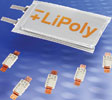Thermal protectors for LiP battery cells
14 November 2012
Circuit & System Protection

Designers are increasingly turning to high-capacity, envelope-like LiP (lithium polymer) cells to optimise space in media tablets, ultra-thin PCs, electronic readers and other small, slim consumer electronics. At the same time, battery manufacturers have been challenged to find ultra-compact over-temperature protection devices that can meet the higher currents typically found in these applications.
In response, TE Circuit Protection developed the MHP-TA series of low-profile (L: 5,8 mm x W: 3,75 mm x H: 1,15 mm) resettable thermal cut-off (TCO) devices for lithium battery protection. The devices feature a 9 V d.c. rating, two product categories with different levels of current-carrying capacity, and multiple cut-off temperature ratings.
The MHP-TA series is an extension of TE’s MHP (Metal Hybrid PPTC) technology, which connects a bimetal protector in parallel with a PPTC (polymeric positive temperature coefficient) device.
The new series comprises nine devices with two levels of current carrying capacity: low-current MHP-TA6-9 products with an approximately 6 A hold current at 25°C, and high-current MHP-TA15-9 products providing a hold current of approximately 15 A.
The low-current MHP-TA6-9 devices are available in four different temperature ratings (72°C, 77°C, 82°C, 85°C) and the high-current MHP-TA15 devices in five ratings (72°C, 77°C, 82°C, 85°C, 90°C).
Further reading:
Smarter protection without disruption
NewElec Pretoria
Circuit & System Protection
Designed for operations still running without integrated automation, NewElec’s retrofit-friendly systems let you upgrade performance and safety without overhauling your entire network.
Read more...
Circuit breaker for reliable, compliant protection
RS South Africa
Circuit & System Protection
Legrand’s low-voltage power distribution portfolio encompasses the DX3 range of miniature circuit breakers, designed to deliver dependable protection in residential, commercial and industrial installations.
Read more...
Reducing noise on power supply lines
Future Electronics
Circuit & System Protection
Murata has introduced the EMIFIL ESD Series Noise Filters, a breakthrough solution engineered for superior noise suppression and enhanced electrostatic discharge (ESD) protection.
Read more...
Clearing the Static: Fundamental principles of static control
Actum
Circuit & System Protection
Controlling electrostatic discharge in electronics manufacturing is essential with effective ESD programs built on six key principles.
Read more...
Electrical fire safety in lithium-ion battery rooms
Circuit & System Protection
Pratliperl is a non-combustible, ultra-lightweight aggregate that can be mixed with cement and applied as a plaster or screed to walls, floors, and ceilings.
Read more...
Clearing the Static: ESD training in the workplace
Actum
Circuit & System Protection
To protect sensitive electronic components, A structured, consistent, and sustainable ESD training program is essential.
Read more...
Protect your pumps – protect your profit
NewElec Pretoria
Circuit & System Protection
In South Africa’s demanding agricultural landscape, irrigation is not just an essential service – it is the heartbeat of farm productivity.
Read more...
Clearing the Static: ESD and installation: A durable antistatic solution
Actum
Circuit & System Protection
ESD flooring provides a reliable, long-term solution for managing static electricity by safely dissipating static charges through the floor to a designated ground point.
Read more...
Why wait to automate
NewElec Pretoria
Circuit & System Protection
NewElec’s initiative helps you gain operational visibility via HMI or PLC by retrofitting intelligent motor protection relays without replacing MCCs or rewiring the plant.
Read more...
Clearing the Static: Effectively control static in your workplace
Actum
Circuit & System Protection
Controlling electrostatic discharge in the workplace is crucial to protect sensitive electronic equipment from damage. Implementing an ESD control program involves various measures and tests.
Read more...


